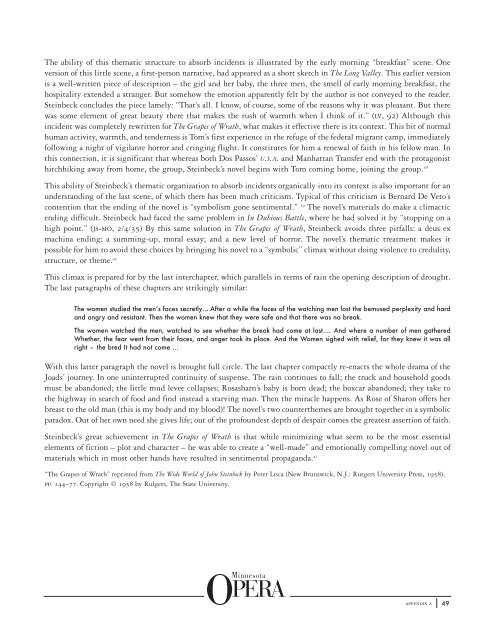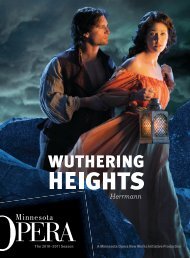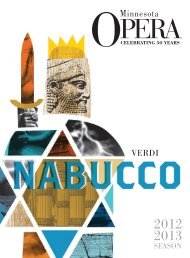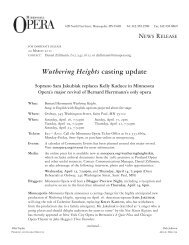You also want an ePaper? Increase the reach of your titles
YUMPU automatically turns print PDFs into web optimized ePapers that Google loves.
The ability of this thematic structure to absorb incidents is illustrated by the early morning “breakfast” scene. One<br />
version of this little scene, a first-person narrative, had appeared as a short sketch in The Long Valley. This earlier version<br />
is a well-written piece of description – the girl and her baby, the three men, the smell of early morning breakfast, the<br />
hospitality extended a stranger. But somehow the emotion apparently felt by the author is not conveyed to the reader.<br />
Steinbeck concludes the piece lamely: “That’s all. I know, of course, some of the reasons why it was pleasant. But there<br />
was some element of great beauty there that makes the rush of warmth when I think of it.” (LV, 92) Although this<br />
incident was completely rewritten for The <strong>Grapes</strong> of Wrath, what makes it effective there is its context. This bit of normal<br />
human activity, warmth, and tenderness is Tom’s first experience in the refuge of the federal migrant camp, immediately<br />
following a night of vigilante horror and cringing flight. It constitutes for him a renewal of faith in his fellow man. In<br />
this connection, it is significant that whereas both Dos Passos’ U.S.A. and Manhattan Transfer end with the protagonist<br />
hitchhiking away from home, the group, Steinbeck’s novel begins with Tom coming home, joining the group. 38<br />
This ability of Steinbeck’s thematic organization to absorb incidents organically into its context is also important for an<br />
understanding of the last scene, of which there has been much criticism. Typical of this criticism is Bernard De Veto’s<br />
contention that the ending of the novel is “symbolism gone sentimental.” 39 The novel’s materials do make a climactic<br />
ending difficult. Steinbeck had faced the same problem in In Dubious Battle, where he had solved it by “stopping on a<br />
high point.” (JS-MO, 2/4/35) By this same solution in The <strong>Grapes</strong> of Wrath, Steinbeck avoids three pitfalls: a deus ex<br />
machina ending; a summing-up, moral essay; and a new level of horror. The novel’s thematic treatment makes it<br />
possible for him to avoid these choices by bringing his novel to a “symbolic” climax without doing violence to credulity,<br />
structure, or theme. 40<br />
This climax is prepared for by the last interchapter, which parallels in terms of rain the opening description of drought.<br />
The last paragraphs of these chapters are strikingly similar:<br />
The women studied the men’s faces secretly…. After a while the faces of the watching men lost the bemused perplexity and hard<br />
and angry and resistant. Then the women knew that they were safe and that there was no break.<br />
The women watched the men, watched to see whether the break had come at last.… And where a number of men gathered<br />
Whether, the fear went from their faces, and anger took its place. And the Women sighed with relief, for they knew it was all<br />
right – the bred It had not come …<br />
With this latter paragraph the novel is brought full circle. The last chapter compactly re-enacts the whole drama of the<br />
Joads’ journey. In one uninterrupted continuity of suspense. The rain continues to fall; the truck and household goods<br />
must be abandoned; the little mud levee collapses; Rosasharn’s baby is born dead; the boxcar abandoned; they take to<br />
the highway in search of food and find instead a starving man. Then the miracle happens. As Rose of Sharon offers her<br />
breast to the old man (this is my body and my blood)! The novel’s two counterthemes are brought together in a symbolic<br />
paradox. Out of her own need she gives life; out of the profoundest depth of despair comes the greatest assertion of faith.<br />
Steinbeck’s great achievement in The <strong>Grapes</strong> of Wrath is that while minimizing what seem to be the most essential<br />
elements of fiction – plot and character – he was able to create a “well-made” and emotionally compelling novel out of<br />
materials which in most other hands have resulted in sentimental propaganda. 41<br />
“The <strong>Grapes</strong> of Wrath” reprinted from The Wide World of John Steinbeck by Peter Lisca (New Brunswick, N.J.: Rutgers University Press, 1958),<br />
pp. 144–77. Copyright © 1958 by Rulgers, The State University.<br />
appendix a<br />
49








